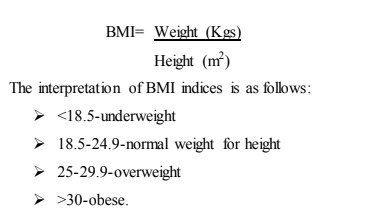1.Anthropometry
Anthropometry is the measurement of body size, weight and proportions to evaluate
nutritional status. Various measurements are taken and compared to standards typical
of the reference population where deviations indicate abnormal nutritional status. The
measurements commonly used are:
-Weight
One of the most important measurements in nutritional assessment is body weight.
Changes in weight among young children can be a useful indicator of the general
health and well-being of the entire population. Weight is used to track growth or
failure to grow in children. Weight can be used together with age to compute the
weight for age index that is used to determine if one is underweight.
-Height/Length
Height or length of children changes over time and is dependent on their nutrient
intake and utilization. The height measurement can be used in conjunction with the
weight measurements to compute the height for weight index which is an indicator for
wasting. Height measurement can also be used together with age to compute the
height for age index, an indicator for stunting.
-Mid upper arm circumference (MUAC)
These are rapid and effective measures that predict risks of death among children 12-
59 months.
-Skin fold thickness
This is a measure of indirectly estimating the percentage of body fat by measuring the
thickness of a double fold of skin and compressed subcutaneous adipose tissue on the
triceps. The measurement is taken using the skin fold calipers.
-Head circumference
This is a measurement used for screening procedures to detect abnormalities of the
head and brain growth especially in the first year of life
-Body Mass Index (BMI)
This is a useful tool when measuring an adult’s nutritional status. Weight and height
measurements are taken and used to compute the index.

2.Biochemical assessment
This is a measurement of nutrients in blood, urine and other biological samples.
Actual levels of particular nutrients may be measured and expressed in relation to the
expected normal values. Compared to other methods, biochemical assessment
provides the most objective and quantitative data on nutritional status. For example
hair can be analyzed to determine zinc status, urine to determine protein levels and
blood for haemoglobin.
3.Clinical assessment
This entails the taking of medical history and physical examination to detect signs and
symptoms of deficiency or general malnutrition. It involves looking at the body and
detecting changes in its external appearance. For example changes in hair, face, eyes,
lips, skin, teeth, gums, tongue can be used determine the presence of nutritional
deficiencies.
4.Dietary assessment
This involves the assessment of food consumption of a group of individuals over a
period of time. Data on foods consumed assists in the identification of nutrient intake.
Interpretation of dietary intake involves use of food consumption tables. Nutrient
intake in dietary methods is used to complement anthropometry, biochemical and
clinical data. Some of the methods used to assess the dietary intake of individual
include:
-Food frequency recall
This is an assessment method commonly used in nutrition assessment or survey to
determine dietary intake. It involves establishing the frequency of which certain types
of foods are consumed over a specified time frame normally a week or two. The
frequency of consumption could be coded as: frequently consumed, food item
consumed once a week to many times a day; not frequently consumed, food items
consumed no more than twice a month and never consumed, food items not consumed
at all. The questionnaire consists of two components: a list of foods and a set of
frequency of use response categories.
-24-Hour dietary recall
In this method the respondent is asked to remember in detail the type and quantity of
foods consumed during the previous 24 hours. Detailed descriptions of all foods and
beverages consumed including the cooking methods are recorded in household
measures then converted into grams or milliliters. The amounts of various nutrients
are then calculated using the food composition tables.
-Dietary history
It involves obtaining data retrospectively on the patterns of food consumption during
a specified period of time, usually in the past one month, two weeks or even longer
period of time.
Titany answered the question on
November 5, 2021 at 08:23